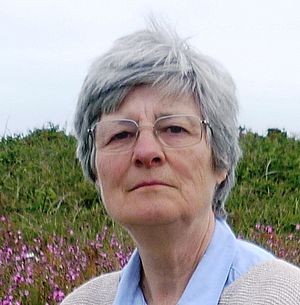Hilary Ockendon facts for kids
Quick facts for kids
Hilary Ockendon
|
|
|---|---|
 |
|
| Born |
Hilary Mason
1941 (age 83–84) Derby, UK
|
| Education | Derby High School for Girls |
| Alma mater | University of Oxford (BA, DPhil) |
| Spouse(s) | |
| Scientific career | |
| Fields | Mathematics Fluid Mechanics Asymptotic Methods Industrial applications |
| Institutions | University of Oxford GCHQ |
| Thesis | Studies in Relaxing Gas Flow (1968) |
| Doctoral advisor | David Spence |
Hilary Ockendon, born Hilary Mason in 1941, is a brilliant British mathematician. She worked at the University of Oxford for many years, retiring in 2008. Her work focused on using mathematics to solve real-world problems, especially those in industry.
She is an expert in fluid dynamics, which is the study of how liquids and gases move. For example, she has studied how to stop coffee from sloshing out of a cup! She is also an emeritus fellow at Somerville College, Oxford. This means she is a retired member who still has a special connection to the college.
Contents
Hilary Ockendon's Early Life and Education
Hilary Ockendon was born in Derby, UK, in 1941. She went to Derby High School for Girls from 1946 to 1959. After finishing high school, she began studying mathematics at the University of Oxford in 1959. She was a student at St Hilda's College, Oxford.
After graduating, her first job was at GCHQ. This is a British intelligence and security agency. After two years, she returned to Oxford. She took a research and teaching job at Somerville College, Oxford. She earned her DPhil (a high-level research degree) in 1968. Her research was about how gases flow.
Hilary Ockendon's Career at Oxford
After getting her DPhil, Hilary Ockendon became a Tutorial Fellow at Somerville College. She also became a lecturer at the University of Oxford. She held these important positions until she retired in 2008. From 1988 to 1990, she also served as the Vice-Principal of Somerville College.
Between 1994 and 2002, she was the director of the Oxford Centre for Industrial and Applied Mathematics. This center is part of the University of Oxford. She is now an emerita member there. Since 2008, she has been an Emeritus Fellow of Somerville College, Oxford.
Leading in Mathematics
Hilary Ockendon was also the president of the European Consortium for Mathematics in Industry. She held this role from 2001 to 2003. This group helps connect mathematics with industrial problems across Europe.
Hilary Ockendon's Research Work
Hilary Ockendon started her research in fluid mechanics. This is the study of how fluids (like water or air) move. Soon, she became involved in "Study Groups with Industry." These groups started in Oxford in 1968. Since then, much of her work has been about solving problems for different industries.
Solving Industrial Problems
The industrial problems she worked on came from many different areas. However, they mostly focused on how fluids and solids behave. She was especially interested in problems from the textile industry. She also had a long-standing interest in how waves behave in fluids and solids.
Hilary Ockendon also co-wrote two textbooks about Fluid Mechanics. These books came from the courses she taught at Oxford.
Books by Hilary Ockendon
Hilary Ockendon has written several books, including:
- Inviscid Fluid Flows (with Alan B. Taylor, 1972; 1983)
- Viscous Flow (with John Ockendon, 1995)
- Waves and Compressible Flow (with John Ockendon, 2004; 2nd ed., 2015)
Promoting Industrial Mathematics
Hilary Ockendon has been very keen on promoting Industrial Mathematics in Europe. She did this through the European Consortium for Mathematics in Industry (ECMI). She was a council member from 1998 to 2005. She was also the president from 2001 to 2003. Later, she served as executive director from 2012 to 2015.
Awards and Special Recognitions
Hilary Ockendon has received several honors for her work:
- She received an honorary Doctor of Science (DSc) degree from the University of Southampton in 1999.
- She became an honorary member of the European Consortium for Mathematics in Industry (ECMI) in 2018.
Personal Life
Hilary Mason married John Ockendon in 1967.

